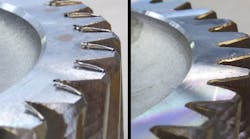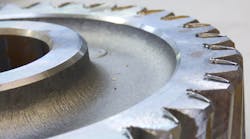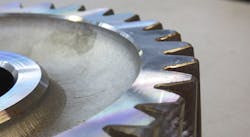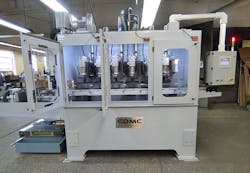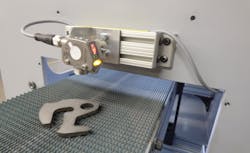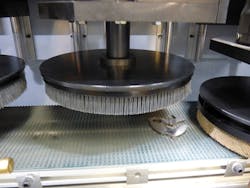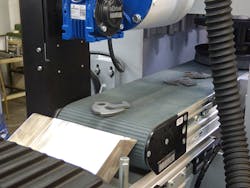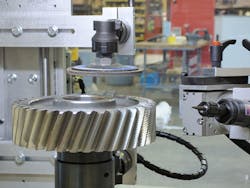Adam Mutschler always knows when it's time for a manufacturer's tooling to be replaced. It's written all over the gears, sprockets and other metal pieces sent to his company, Cleveland Deburring Machine Company. The more burrs, or excess material left on the part, the less life the cutting or shaping tool has.
That's fine by him, as the more burrs the better for CDMC. The small shop on Cleveland's industrial west side, which we recently visited, custom makes automatic deburring machines, such as magnetic through-feed conveyor models, and calibrates them to smooth even the roughest parts and sharpest edges, which are created when tooling is nearing end of service
"We have to know what's your worst case scenario, and work backwards form there," says Mutschler, who co-founded the company with his brother Eric in 2007. "If we don’t know what that is, and we design this process around this part that was cut with brand new tools and babied through the whole process, what's going to happen when the tool wears?"
What will happen depends on what the part is being used for, of course, but it's usually nothing good. "Everything is a tighter fit, everything is more precise," he says.
Before
After
"For this part, we're trying to stay under 8/1000 of an inch edge break," says Mutschler as he displays one bulky helical gear. "Anything more than that would be an issue for the surface contact of the chain."
This is a major reason why automated deburring has replaced manual. The obvious risk for hand injuries not withstanding, the quality and consistency of a human cannot match a machine's.
"Parts may look good on Monday morning, but by Friday afternoon they have spurs all over them," Mutschler says. He adds that human error can deburr too much, ruining the part and costing time and money.
About 90% of Cleveland Deburring's customers are Tier 1 and 2 suppliers for the automotive industry, so it's vital that its machines can finish flawlessly. For example, an imperfect helical gear with sharp teeth used in a cam drive system will eventually wear the other parts down and throw off the timing.
Current machine cutting machines are capable of removing these sharp and jagged edges themselves, but any production manager would rather have their workhorse equipment dedicated to quantity, not quality. The applications those parts will be used for still demand quality, creating a double edged sword.
"Deburring is looked at as necessary evil," Mutschler says. "It's not a value added thing."
From January to October 2017, new orders for machine tools reached $3.6 billion, a 7.6% increase over the comparable 2016 period. More tools, more parts that need to be deburred, hence CDMC is having its busiest time ever. The family-owned business is booked solid through at least Q2 of 2018.
Mutschler allowed us to peek inside a recently completed Mag Series to show us how the magnetic conveyor process works.
First, the part, in this case a seatbelt bracket, is dropped onto the belt. A series of magnets is embedded underneath to hold the part down. Then a laser sensor measures the height of the part before it enters the tunnel.
Circular metal brushes of differing grit descend and polish the thin, low profile piece of stainless steel as it passes through the meter-long span.
Cooling nozzles spray mist to increase the life of the brushes. This particular machine only polished one side at a time, though they have made versions to finish both surfaces that have two belts, one with a brushes above the other below. The parts can also go through a third conveyor for demagnetizing.
The particulates are filtered and directed to a magnetic rod enclosed in plastic tube for easy clean up. The process can accommodate as many as 1,200 parts/ hr.
A feature called Auto Amp Compensation senses and compensates the wear on the brushes to ensure consistency.
In one case, they dropped a customer's cost of deburring from $.04 to 1/8 of a penny.
CDMC makes several other machines, ranging from the CDMC Model 5000 for parallel axis gear deburring which employs four rotary brushes to portable options for basic orbital brushing. It's also an authorized FANUC integrator.
Despite all the automatic version they have, even CDMC will reluctantly resort to manual deburring on occasion— when certain components that comprise deburring machines arrive a little rough around the edges.
"Seeing a sharp edge in one of our machines, it's the ultimate sin: a burr on a deburring machine," says Mutschler. "I'll go grab a hand file and take care of it myself sometimes."
To get or quote or more info from Cleveland Deburring, please visit: http://cdmcmachine.com/contact/










